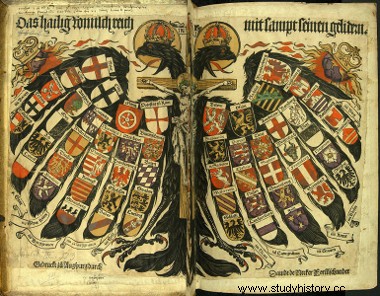(Ufes) In February 1076, Pope Gregory VII, reacting against the decision of the German bishops to proclaim themselves independent from the Holy See, excommunicated Henry IV, sovereign of the Holy Roman Empire, in the following terms:The episode is part of one of the most important conflicts that occurred in the Medieval Period between the papacy and the Empire, called “Question of Investitures” (1075-1122), which consisted of:
a) in the resumption, by the Holy See, of the land properties granted in lease to the German princes so that they could invest in agricultural production, destined to supply emerging urban centers;
b) in Gregory VII's decision, proclaimed before the bishops gathered at the Council of Avignon, to prevent by all means the onslaughts of Henry IV and his allies against Italy, which led the papacy to seek the support of the French monarchy;
c) in Gregory VII's condemnation of the interference of secular power in the composition of the clergy, especially with regard to the appointment of bishops by sovereigns;
d) in Henry IV's repudiation of the papacy's claims to consecrate the German knights, since historically such a prerogative belonged only to the emperor, as the legitimate heir of the Roman Caesars;
e) in the split between the Holy See and the German monarchy, on account of the revelation that papal agents had penetrated the territory of the Holy Roman Empire with the aim of raising the nobility against Henry IV.
Look at the image and then read the text:

Coat of arms of the Holy Roman Empire *
* Image credits:Commons
“[... the figure of the double-headed crowned eagle is unequivocally – from an iconographic point of view – a symbol of power, and imperial power. Such representation, as said before, symbolized the political status of Empire, of the Holy Roman Empire, which throughout the 17th century still displayed it with grandeur.” (TRINITY, Jaelson Bitran. The Empire of a Thousand Years and the art of the “baroque time”:the double-headed eagle as an emblem of Christianity. Anais do Museu Paulista. Sao Paulo. no. To be. v. 18. n. 2. p.11-91. Jul. - Ten. 2010.)
In the symbolic representation of the Holy Empire, the two heads of the eagle indicate, respectively:
a) spiritual power (exercised by the emperor) and secular/earthly power (exercised by the pope).
b) Ancient Rome and Modern Germany.
c) the Roman Empire of the West and the Roman Empire of the East.
d) spiritual power (exercised by the Pope) and secular/earthly power (exercised by the Emperor).
e) Christ and Pilate.
question 3The Holy Roman Empire was formed after the weakening of the Carolingian Empire. What was the event that effectively marked the formation of this empire?
a) The retaking of the Iberian Peninsula by the Spanish kings.
b) The coronation of Otto I, in 962 AD, by Pope John XII.
c) The occupation of Rome by the Huns.
d) The taking of Constantinople by the Ottoman Turks.
e) The Investiture Quarrel.
question 4The Holy Roman Empire resisted, as a political-religious unit of European Catholic nations, until the beginning of the 19th century. What political process emerged in Europe and brought about the downfall of the Holy Roman Empire?
a) The Bolshevik Revolution in Russia.
b) The Franco-Prussian War.
c) The process of formation of absolutist monarchies after the religious civil wars.
d) The Hundred Years War .
e) The French revolutionary process and the rise of Napoleon Bonaparte as Emperor.
answers Question 1Letter C
The Investiture Question, or Investiture Quarrel, was the height of the divergence between spiritual power and secular power in the Middle Ages. The investiture, or the act of investing (that is, appointing), consisted in assigning clerics positions within the Church hierarchy. Gregory VII, who was also responsible for a profound reform in the Church, understood that only the Pope (representative of spiritual power) could execute the act of investiture in the ecclesiastical sphere. The excommunication of Henry IV was a gesture of disapproval by the pope to the king because Henry IV (who was a representative of the secular/political power) wanted to invest, in addition to the nobles, also the clerics.
Question 2Letter D
The double-headed eagle of the coat of arms representing the Holy Roman Empire represents spiritual power and secular, or political power. The crowning of the two heads conveys the idea of the union between the two spheres, without, however, having a superposition of the functions of one in relation to the other. The authorities representing such powers are the pope, representative of spiritual power (the Catholic Church), and the emperor, representative of secular, or political power.
Question 3Letter B
Otto I the Great, at the time of the year 962, was considered the sovereign of Germania, the Franks, the Lombards and the region of Pavia. Although the appellation “Holy Empire” appears later, the coronation of Otto I by Pope John XII marked the beginning of the long-troubled relationship between the spiritual (Church) and secular (Empire) powers.
Question 4Letter E
The French Revolution was guided by anti-aristocratic and anti-clerical ideals, given that its protagonist was the bourgeoisie. Since the aristocracy and the clergy were the basis of the absolutist system and, consequently, the mainstay of the dynasties that made up the Holy Roman Empire, both ended up becoming the main targets of the revolutionaries. Napoleon Bonaparte's accession to power in 1799 and his conversion to emperor dissociated from the Holy Empire culminated in the total collapse of the latter in 1806.
